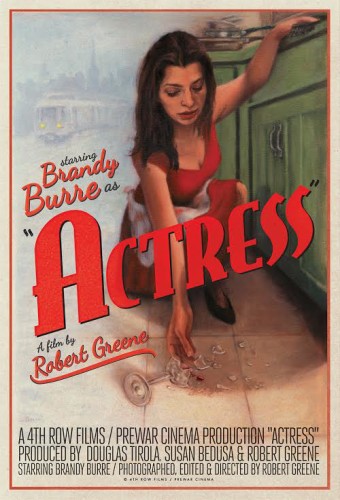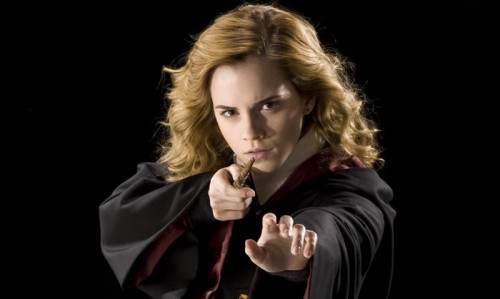This is a guest post by Robert Greene and Brandy Burre.
From Director Robert Greene:
How does a man make a movie about a woman who is going through a crisis in her life that he, despite being the same age (with the same ambitions, the same number of children that are the same age in the same town), will never have to deal with because he’s a man? That’s what I’ve tried to do with my new nonfiction film Actress, which stars my neighbor and friend Brandy Burre as she tries to balance motherhood and artistic dreams in the face of a suddenly tumultuous domestic situation. The answer in this case: you wind up the toy and hold on tight.
Brandy got pregnant when she was filming her final appearances on HBO’s legendary show The Wire, in which she played political consultant/vixen Theresa D’Agostino. Her life didn’t immediately settle (at one point she was doing a theater run far away from Tim, the baby’s father), but she eventually moved to Beacon, New York to raise a growing family. I moved next door to her a few weeks after she came to Beacon. Five years later we began filming what would become the movie. Its original title was Mother As Actress.
In the film I follow Brandy’s unfolding drama as-it-happened, hanging the film on her trained actor expressions and captivating ability to theatrically display fragility, anger, and force of will. The film is a documentary in the sincerest way; Brandy’s performance is the truth I was observing. Actress is about the roles we play and how we get trapped in them; the role the viewer sees Brandy wrestle with most vigorously might be the role of documentary subject.
The project started from the formal question, “What happens when you film an actor in an observational documentary?” before the story took us in unexpected places. I also know that women, especially mothers in their later 30s, are harshly under-represented in movies. In general, too, I begin from the point of view that documentaries are inherently exploitative, that a power exchange is created when one person films another, not to mention when a man films a woman. This may be especially true when that man is exploring genres such as melodrama, which have traditionally been called “women’s films.”
The best way to short circuit the potential calamity of this exchange is to foreground the exploitation, to make it part of what the viewer is watching while they follow the story. The way a man can make a documentary about a woman in this situation, then, is to dive deep into the contradictions of the nonfiction form and display the mess onscreen. Documentaries are made of the tension between order and chaos, between directing and living. Letting these tensions show (and allowing space for the viewer to think about these tensions, including questions of gender and exploitation) cedes some of the power of the image to the person in front of the camera.
That person in this case is Brandy, a complex, theatrical, mercurial force of nature. It was not always easy to “cede power” of my film to this magnificent creature, and I wasn’t about to do it just because she was a woman. She was hesitantly stepping forward, too, though I wouldn’t have been able to tell; by the time she said yes I had already become somewhat obsessed with the possibilities of filming her and how my ideas would mingle with what I could never have predicted. What happened, of course, was that Brandy’s force, her power, her fragility, her ability to make every scene crackle was the film I wanted to make. Soon my ideas were dwarfed by this bright star and it was now our film, though it obviously never could have remained just mine.
This film was very hard to make, but ultimately I think we’ve arrived at something productive and meaningful. I think Brandy agrees, but let’s see what she thinks in her own words.
From Subject/Star Brandy Burre:
Indeed being the subject of a documentary, actor or no, is a dicey proposition. When Robert first introduced the idea that he “follow my journey of getting back into acting,” I declined. The problem as I saw it: I’ve never had the desire to trudge into the business of acting as it formally exists. End of story.
The fact that Robert couldn’t, in many ways, understand my views as a woman and mother further distanced me from the idea. The assumption I inferred in Robert’s scheme was that I had lost my way as an actor and was in need of finding it, that my life without acting was lacking in some way and needed to be rectified, as if my career had been on a clear path, I had been derailed by having children, and I simply needed to hop back on the train and resume my efforts where I had left off.
Clearly he didn’t understand my rogue path to landing the role on The Wire. Nor did he understand the extent of my other work as a theater artist and musician. How could he know I had made definitive choices, defying the one size fits all rigmarole allotted to aspiring artists in America (those without lineage or trust funds, that is)? I had no desire to prop up a false perception of a typical actor’s life, or worse, come across as a failure or desperate in some way.
But then there is Robert, a persistent hornet of a person. Taking a different approach with me, he threw down the gauntlet: we just start filming. We turn on the camera and see where it leads, even if that destination is nowhere. We film for the sake of filming, make art for art’s sake, he the filmmaker and I, the muse to his musings. Hmm… Now this got my mind a-churning.
How could I say no to this exercise? What is it to play the role of one’s self? What actions define me as an individual, and what are the boundaries of my existence that I’m forced to question when confronted with a camera lens as witness?
I was sufficiently stung by Robert’s passion and commitment to the potential of this project. If he accepted me with all my contradiction and parody, force and feebleness, without need for outcome, who was I to deny him? From this moment on, Robert found in me his willing cohort, conspirator, and collaborator. And once I commit to a project, I invest my entire soul to it.
I am endlessly proud of Actress and the bravery it took to make this film. The bravery to be as truthful and raw as I knew how to be. Robert met me as a fellow artist without definition of gender, and this was his greatest gift to me and to women in general. The fact that Actress might be considered a “woman’s film” is because my story was truthfully told within the context of itself, not with a male-dominated agenda. And in case it needs clarifying, the context of me is ALL woman.
Actress is currently building an audience and raising funds for music rights on Seed&Spark.com.
Brandy Burre is an American actress best known for her portrayal of Theresa D’Agostino on the HBO Series The Wire. Currently, she is the subject of Actress, the critically acclaimed documentary from Robert Greene. Other recent credits include Alex Ross Perry’s Listen Up Philip and Phil Pinto’s “Diplo Revolution” music video. Also a musician and mother of two, Brandy has performed many great roles on professional stages across the country. She has an MFA in Acting from Ohio University.
Robert Greene is a filmmaker and writer. He was named one of the 10 Filmmakers to Watch in 2014 by The Independent and received the 2014 Vanguard Artist Award from the San Francisco DocFest. Robert’s films include Actress (2014), Fake It So Real (2012) and Kati With An I (2010). He has edited over a dozen films, including Alex Ross Perry’s Listen Up Philip and Amanda Rose Wilder’s Approaching the Elephant. Robert writes for Sight & Sound and other outlets.












